BioCradle is macroporous beads made from cellulose.
BioCradle is suitable for microcarrier of cell culture.
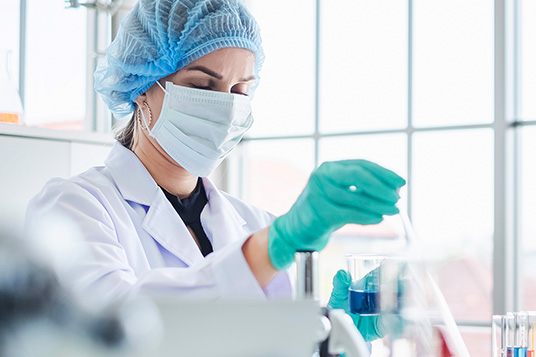
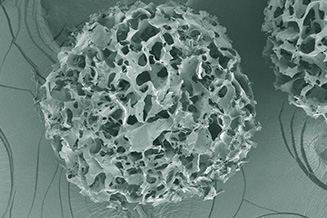
Micro scope image of BioCradle.
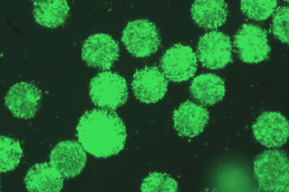
Image of BioCradle attached by cells.
HOME > BioCradle

BioCradle is macroporous beads made from cellulose.
BioCradle is suitable for microcarrier of cell culture.


Micro scope image of BioCradle.

Image of BioCradle attached by cells.
Microcarrier cell culture is extensively used in the commercial production of vaccines and biopharmaceuticals based on adherent cells. BioCradle microcarriers are composed of macroporous cellulose beads with positively charged N, N-diethylaminoethyl (DEAE) groups. The large specific surface area, superior cell adherence, and cell proliferation characteristics offered by BioCradle facilitate high-density cell culture. Inside the BioCradle pores, cells are protected from the shear forces generated within the stirred culture vessel making this technology ideal for the scale up of adherent cell culture. The positive charge also enables floating cells to be efficiently immobilized and cultured at high density. Furthermore, the high-density culture conditions within the microcarriers influence cell-to-cell interactions and promote cellular functions such as protein synthesis. These unique features enable the BioCradle microcarriers to function as ‘cradles’ for the culture cells.
Cross-linked Cellulose

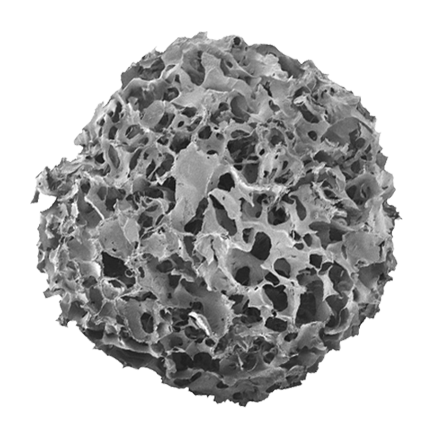

BioCradle was developed to efficiently culture adherent cells in a stirred culture vessel. It is particularly suited to the production of biopharmaceuticals using recombinant cells such as CHO cells. Its positively charged macroporous structure also makes it useful for immobilized culture of floating cells such as hybridomas.
Cells were found in the interior of the BioCradle beads, where the effects of shear stress are lessened.
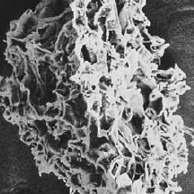
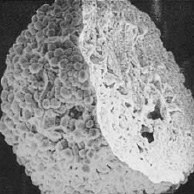
Inside the BioCradle pores, cells are protected from the shear stress generated in the stirred culture vessel, making this technology ideal for the scale up of adherent cell culture.
Cell number was higher for culture with BioCradle beads over a broader range of higher ISF (Integrated Shear Factor) values.
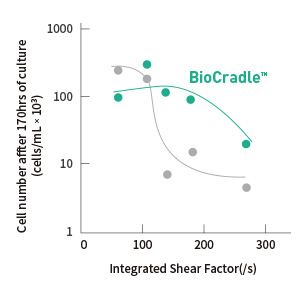
Comparison study was conducted by using vero cell ATCC CCl-81 as are presentative of vaccine manufacturing cell line. Below table is a list of microcarriers we evaluated. We evaluate 2 types of BioCradle, one is low charged, the other is high charged. Additionally we evaluated two types of commercially available surface type microcarrier. As the below table shows, BioCradle has larger surface area.
| Microcarrier Type | Surface Modification | Particle Size (um) | Specific Surface Area (cm2/g-dry weight) |
|---|---|---|---|
| BioCradle L | DEAE, low charge | 200 - 280 | 11,000 |
| BioCradle H | DEAE, high charge | 200 - 280 | 11,000 |
| product A* | DEAE | 147 - 248 | 4,400 |
| product B* | collagen | 141 - 211 | 2,700 |
*commercially available(surface type)
As a result of vero cell growth, high charged BioCradle showed highest cell density when microcarriers concentration was same.
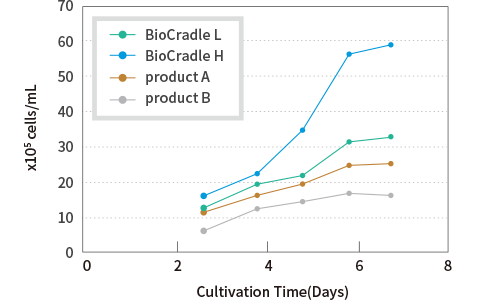
We are willing to provide free sample of each type (2g).
| Characteristics | BioCradle H | BioCradle L |
|---|---|---|
| Base material | Cellulose | |
| Particle size | 200 – 280 μm | |
| Charge group | Diethylaminoethyl (DEAE) | |
| Quantity | 20 g, 1000 g | |
| Ion Exchange capacity | 1.65 – 1.95mmol Cl-/g | 0.90 – 1.20mmol Cl-/g |
| Specific gravity | 1.03g/mL | |
| Effective surface area | 1.1m2/g dry | |
| Average pore diameter | 30μm | |
| Swelling factor | 43 – 55 ml/g | 42 – 46 ml/g |
| Product Name | Catalog No. | Quantity |
|---|---|---|
| BioCradle H20 | BCRH0020 | 20g |
| BioCradle H1000 | BCRH1000 | 1000g |
| BioCradle L20 | BCRL0020 | 20g |
| BioCradle L1000 | BCRL1000 | 1000g |
BioCradle™ is a trademark of Asahi Kasei Corporation.